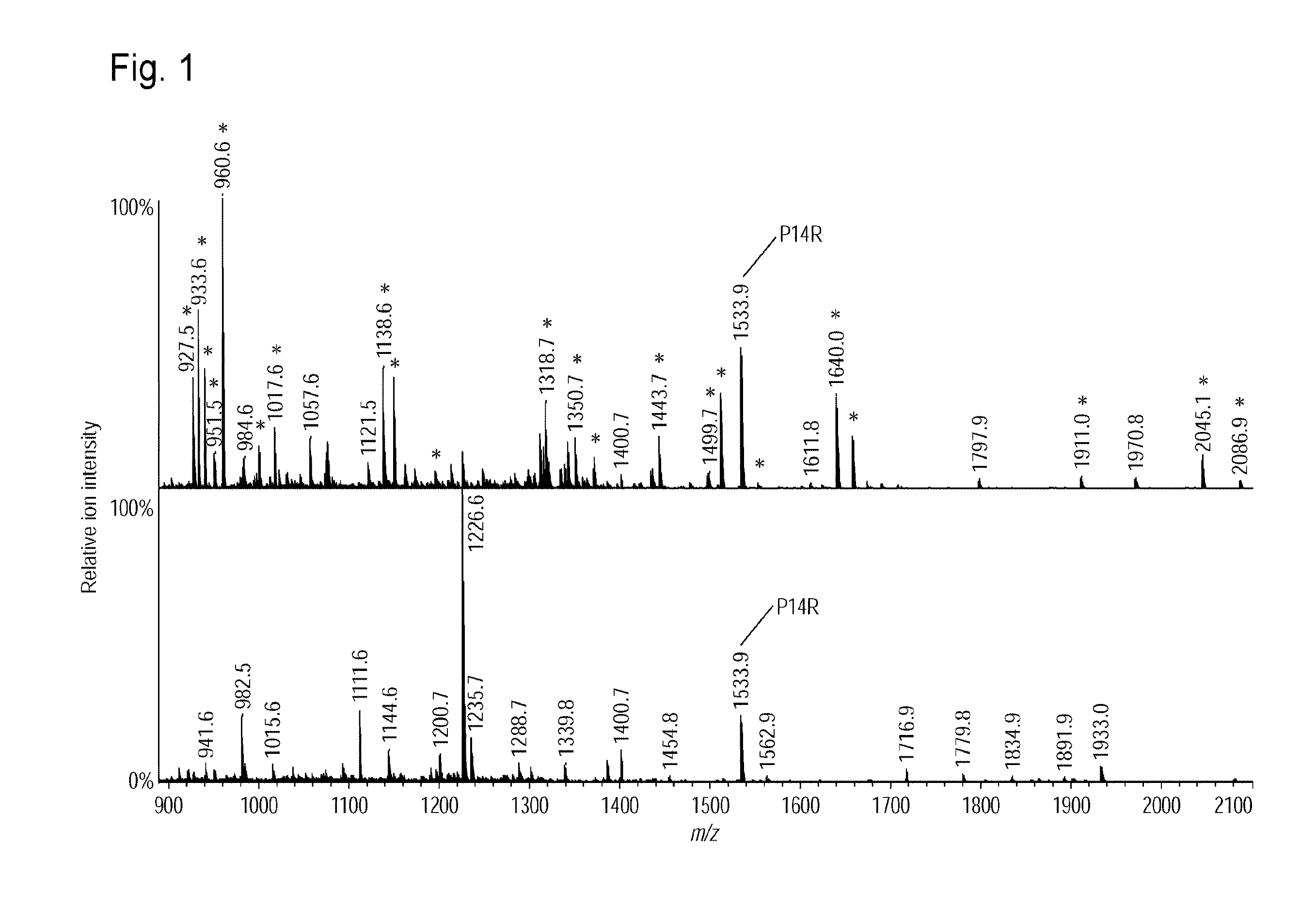Protein detection method using mass spectrometry
- Summary
- Abstract
- Description
- Claims
- Application Information
AI Technical Summary
Benefits of technology
Problems solved by technology
Method used
Image
Examples
example 1
Selection of Peptides to be Analyzed
[0068]Annexin A4 (ANXA4) (SEQ ID NO: 1), which is contained in a trace amount in serum and expected to serve as an ovarian cancer biomarker, was subjected to semi-quantitative detection according to the present invention.
[0069]DEGNYLDDALVR (SEQ ID NO: 7) was selected as a peptide appropriate for the present invention in accordance with the conditions described in Expert Rev. Proteomics 2004, 1 (4), 503-12; and Nat. Biotechnol. 2009, 27 (2), 190-8.
[Preparation of Samples and Protease]
[0070]A purified recombinant protein (ANXA4) that had been obtained from the E. coli expression system was added at a concentration of 3 mg / mL to commercially available human serum (product code 14-402E, Lonza Japan) so that it accounted for 10% of the final volume. The resulting mixture was serially diluted with the serum to prepare samples containing ANXA4 at concentrations of 300, 150, 75, 38, 19, 9, and 5 μg / mL, respectively. The serum samples were inactivated by h...
example 2
Selection of Peptides to be Analyzed
[0081]The above peptides of SEQ ID NOS: 2-11 are preferable peptide candidates for the method of the present invention. In order to select particularly preferable peptides from these peptides, a preliminary experiment was carried out using α2 macroglobulin (A2M).
[0082]A2M protein (product code M6159, Sigma-Aldrich) and purified recombinant protein ANXA4 obtained using an E. coli expression system were adjusted to concentrations of 2 mg / mL and 3 mg / mL, respectively, with the use of phosphate-buffered saline (PBS). Powdered trypsin (product code: 203-09893, Wako Pure Chemical Industries, Ltd.) was dissolved in a 1 mmol / L hydrochloric acid solution to obtain a trypsin solution at a concentration of 10 mg / mL.
[0083]The A2M solution (7.5 μL) and the ANXA4 solution (2 μL) were mixed and PBS (10 μL) was added to the mixture, followed by heating at 56° C. for 30 minutes. Then, 0.5 μL of the trypsin solution was added, followed by digestion at 4° C. for 12 ...
example 3
Preparation of Samples and Protease
[0086]Preparation was carried out in the same manner as Example 1.
[Pretreatment by the Present Invention]
[0087]Pretreatment was carried out in the same manner as Example 1, except that trypsin digestion was carried out at 4° C. for 16 hours.
[Pretreatment by the Conventional Method]
[0088]Pretreatment was carried out in the same manner as Example 1.
[0089]The samples (0.5 μL each) obtained above were desalted using ZipTip.
[0090]Standard peptide P14R (10 pmol) was added to each eluate. One-tenth ( 1 / 10th) by the volume of each eluate was spotted on a μFocusing plate (Shimadzu GLC). After air drying, 1 μL of 3 mg / mL 2,5-dihydroxybenzoic acid was spotted as a matrix. After crystallization, assay was conducted using MALDI MS (AXIMA-Resonance, Shimadzu Corporation). Profiles (200 in total) were obtained at 200 spots by driving raster scanning at a laser intensity of 100 in the positive mid mass mode and accumulated to obtain a mass spectrum...
PUM
 Login to View More
Login to View More Abstract
Description
Claims
Application Information
 Login to View More
Login to View More - R&D
- Intellectual Property
- Life Sciences
- Materials
- Tech Scout
- Unparalleled Data Quality
- Higher Quality Content
- 60% Fewer Hallucinations
Browse by: Latest US Patents, China's latest patents, Technical Efficacy Thesaurus, Application Domain, Technology Topic, Popular Technical Reports.
© 2025 PatSnap. All rights reserved.Legal|Privacy policy|Modern Slavery Act Transparency Statement|Sitemap|About US| Contact US: help@patsnap.com



